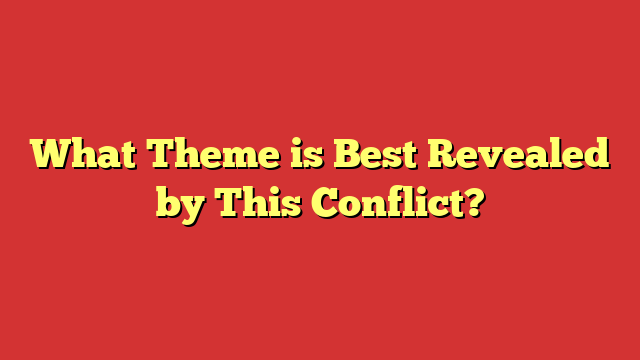What Theme is Best Revealed by This Conflict
Introduction
Literary conflict is the driving force behind every memorable story. It creates tension, propels the narrative, and provides a lens through which readers can explore different themes. Identifying the themes within a conflict can deepen our understanding of a work and allow us to connect with it on a more profound level. In this article, we’ll delve into the nuances of literary conflict, explore the process of unraveling themes, and learn how to analyze conflicts to uncover the central themes of a story.
Understanding Conflict in Literature
Conflict, at its core, is a struggle between opposing forces. It is the element that creates tension and propels the story forward, presenting challenges for the characters to overcome. There are two main types of conflict in literature:
- Internal conflict: This type of conflict occurs within a character, often as a struggle between competing desires, emotions, or beliefs. Examples include guilt, self-doubt, or conflicting loyalties.
- External conflict: This type of conflict takes place between a character and an external force, such as another character, society, or nature. Examples include rivalry, oppression, or a natural disaster.
Conflict plays a crucial role in literature, as it allows authors to explore different aspects of human nature and experience. The way characters navigate these struggles can reveal a story’s underlying themes.
Unraveling Themes in Literature
A theme is the central idea or message of a literary work, often reflecting the author’s perspective on the human condition. Themes are essential because they provide insight into the story’s meaning and evoke emotions, encouraging readers to engage with the narrative more deeply. Some common themes in literature include love, revenge, power, identity, and the nature of good and evil.
Analyzing Conflict to Reveal Themes
To identify the themes best revealed by a conflict, consider the following steps:
- Identifying the central conflict: Determine whether the main conflict is internal or external and identify the opposing forces at play.
- Examining the causes and consequences of the conflict: Delve into the origins of the conflict, its escalation, and its impact on the characters and the story as a whole.
- Analyzing the characters’ motivations and actions: Investigate what drives the characters involved in the conflict, and how their actions and choices shape the narrative.
- Investigating the setting and its influence on the conflict: Consider how the time period, location, and cultural context contribute to the conflict and its resolution.
- Observing the resolution of the conflict and its implications: Examine how the conflict is resolved (if at all) and what this reveals about the story’s themes.
Case Studies: Conflicts and Themes in Classic Literature
A. Case Study 1: Romeo and Juliet by William Shakespeare
- Conflict analysis: The central conflict in Romeo and Juliet is an external one, driven by the rivalry between the Montague and Capulet families. This feud creates a forbidden love between the two protagonists, resulting in a tragic series of events.
- Theme revealed: The themes revealed by this conflict include the power of love, the consequences of blind hatred, and the destructive nature of societal expectations.
B. Case Study 2: To Kill a Mockingbird by Harper Lee
- Conflict analysis: The main conflict in To Kill a Mockingbird is external, centered around racial injustice in a small Southern town. The trial of Tom Robinson, a black man falsely accused of assaulting a white woman, serves as a catalyst for this conflict.
- Theme revealed: The themes revealed by this conflict include the importance of empathy, the loss of innocence, and the struggle against prejudice and injustice.
C. Case Study 3: The Catcher in the Rye by J.D. Salinger
- Conflict analysis: The central conflict in The Catcher in the Rye is internal, as the protagonist, Holden Caulfield, grapples with feelings of alienation, depression, and a desire to protect the innocence of childhood. This internal struggle is exacerbated by external conflicts, such as his interactions with various characters and the challenges of growing up.
- Theme revealed: The themes revealed by this conflict include the complexity of adolescence, the search for identity, and the difficulties of navigating the transition from childhood to adulthood.
Practical Tips for Revealing Themes through Conflict Analysis
To effectively analyze conflicts and reveal themes in literature, consider the following tips:
- Reading actively and critically: Engage with the text by asking questions, making connections, and challenging your assumptions. This will help you to identify and interpret the various conflicts and themes present in the story.
- Taking notes and highlighting key passages: As you read, jot down your thoughts, questions, and observations. Highlight passages that reveal important aspects of the conflict or provide insight into the characters’ motivations and actions.
- Discussing the text with others: Share your thoughts and interpretations with friends, classmates, or online discussion groups. Engaging in conversations about the text can help you to refine your analysis and gain new perspectives on the conflict and its underlying themes.
- Researching the historical and cultural context: Understanding the context in which a literary work was created can provide valuable insight into the author’s intentions and the themes they sought to explore. Research the time period, location, and social issues relevant to the story to gain a deeper understanding of the conflict and its significance.
Conclusion
Analyzing conflicts in literature and identifying the themes they reveal is a rewarding and enriching endeavor. By examining the central conflicts, characters’ motivations, and the broader context of a story, we can uncover the themes that lend depth and meaning to the narrative. As you continue to explore the world of literature, remember to approach each text with an open mind and a willingness to engage critically and thoughtfully with the story’s conflicts and themes. This will enable you to connect more deeply with the work and gain a richer understanding of the human experience.





